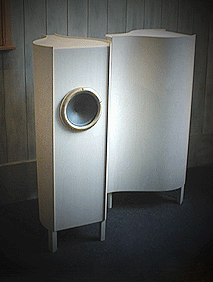| »Rondo«
was our next challenge - in the true sense of the word.
When
we began working on this speaker, our initial goal was to create a very
simple enclosure. It should be the sum total of our knowledge,
including experiences with earlier cabinets and different kinds of
wood. At this stage, we had no inkling that it would become our most
expensive, most complicated - and most amazing speaker yet.
The
basic intention was to develop an enclosure at low cost to our kit
clients. Ideally, we planned to take a thin, pliable sheet of wood,
bend it backwards, and fix both ends into a short "tail". Then we'd saw
a hole in the front, mount the speaker chassis, and presto you'd have
your speaker.
Things went pear-shaped; or, as a German saying
has it: "The devil dwells in details." The tension of the bent wood was
so high that its curves broke, and it would break invariably, no matter
what modifications, tricks or coaxing we tried. Sometimes, it would
shatter a few days after we'd already felt moderately triumphant, but
shatter it would. Obviously, we had to change our approach to the whole
thing: We separated the front from the side flanks and knew instantly
we'd hit the right track. The different prototypes will be shown in a
separate story some day.
After many months of hard work, the
final result was a slender, curved cabinet. It avoids the disadvantages
of designs with parallel sides and is crafted with elaborate
workmanship. The side walls are not pre-formed and are bent into shape
under high tension: a difficult process to master, even more so as the
floor is open and the flanks can be fixed to three sides only. Again,
the design follows the rationale that a loudspeaker housing is
comparable to the corpus of an instrument; it should use rather than
eliminate energies from the driver. Thus we carry on a tradition of
reverberating housing concepts that Western Electric and Altec Lansing
first formulated in the Fifties.
The speaker debuted in Germany at the Frankfurt HighEnd Show 2000.
| | 
At
a time when few full-range speakers were available, it received much
attention for its unusual shape and aestethic appearance. We couldn't
predict that a segment of the DIY-scene would react by staging a run on
vintage radios, only to gut them and fit the speaker units into
plagiarized Rondo enclosures. We are sorry about this and share the
chagrin of the original collectors of those items ( www.6moons.com/rondo.html). Rondo
was the sum of our observations, experience, and research, the
bottomline of years' worth of building enclosures in different types of
wood, thickness and volume with one and the same speaker unit. Arriving
at vastly different results by changing just a few, often minute
parameters has been a profound experience. We are immensely
grateful to Prof. Dr. Nico Schalz, professor of musicology at the
Bremen Conservatory, who was the first to privately give this speaker
intense attention, praise, and feedback. ( www.auditorium23.de/Nico.html, only in German language). We couldn't come to a better conclusion than our French representative in Paris, Alain Choukroun: "Rondo, c'est poesie". For further reading, please see the review about Rondo in Image-HiFi 3/2000 by Roland Kraftand by Thierry Soveaux in Diapason Juli/August 2002 | |